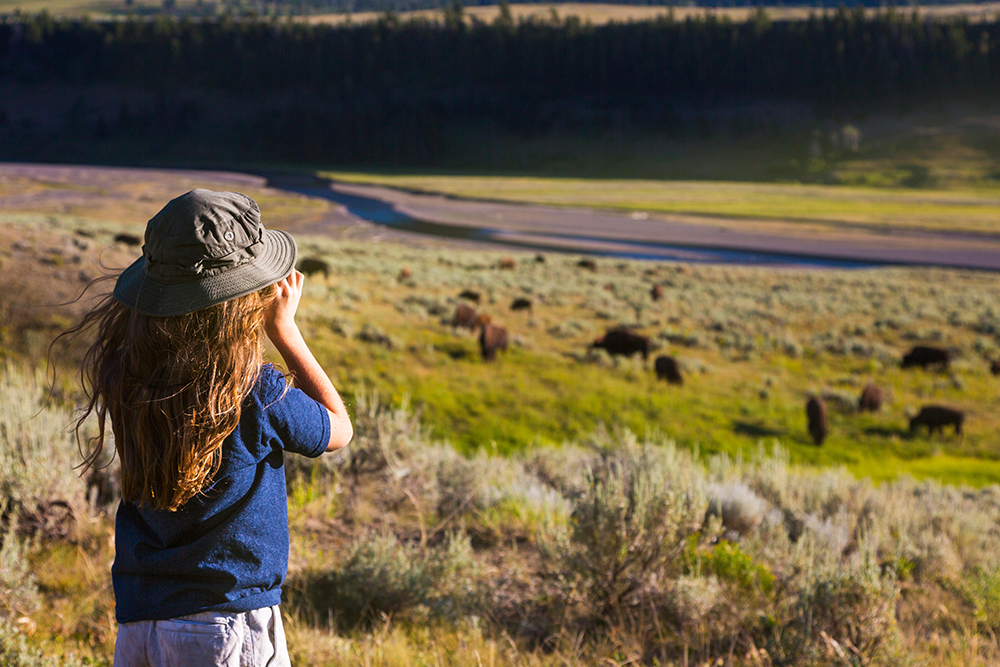
New research co-authored by faculty co-director, Arthur Middleton, is published in Society for Conservation Biology!
Read the research brief below and the full paper here.
Introduction
Across the globe, protected areas attract millions of visitors hoping to see migratory and wide-ranging wildlife. These animals require habitat beyond protected area boundaries, often extending across roads and onto private lands, where wildlife populations are threatened and the costs of conservation are high.
Funding for wildlife conservation around protected areas could come from those who directly benefit from viewing wildlife within protected areas. To explore this idea, researchers surveyed visitors to Yellowstone and Grand Teton National Parks. The survey asked how the opportunity to view iconic wildlife, such as grizzly bears and elk, influenced visitation decisions, how hypothetical declines in wildlife populations might affect park visitation, and whether visitors support paying more per visit to help conserve wildlife around parks.
The research study found that benefits from wildlife viewing in these parks are substantial and depend on successful protection of wide-ranging species abundance. Asking park visitors to fund conservation has broad support from park visitors and may have minimal effects on park visitation rates. Funding collected from park visitors could help maintain the quality of visitors’ experiences and the wildlife populations on which those experiences depend.
Research Findings
- Wildlife viewing: 77% of respondents cited wildlife viewing as a primary reason for their trips to Yellowstone and Grand Teton National Parks.
- High economic value: Wildlife viewing generates an estimated $581 million in annual recreational value in the two national parks.
- Impact of wildlife loss: 48% of respondents would take fewer trips to the parks if there were fewer wide-ranging wildlife to view, which could be about a 15% decrease in overall park visitation.
- Support for conservation fees: Visitors support parks charging a mandatory conservation fee or collecting donations, regardless of income level or political orientation.
- Conservation opportunity: A conservation fee of $5 could raise millions of dollars for wildlife conservation annually while reducing visitation by only one percent.
- Importance of grizzly bears: Those who prioritize seeing large carnivores are willing to pay about 50% more to visit the parks and would continue visiting even if costs increase.
- Understanding tradeoffs: Long-term wildlife declines would likely have a greater negative effect on park visitation than implementing new conservation fees, which visitors largely support.
Tradeoffs in funding wildlife conservation
Habitat conservation around protected areas is critical for wide-ranging wildlife, such as bears and elk. Such conservation is costly, and visitors to U.S. national parks who enjoy viewing this wildlife are not asked to directly contribute to these efforts. Adding new fees to help pay for landscape-scale conservation could decrease visitation, particularly among low-income visitors. Yet the failure to maintain the quality of visitors’ experiences (e.g., by failing to conserve species) could also reduce visitation in the long run. Park managers thus face a conundrum: how does asking visitors to fund conservation compare to failing to fund it?
Asking national park visitors to weigh in
A study published in April 2025 in the journal Conservation Science and Practice explores this question in the context of Yellowstone and Grand Teton National Parks. These parks attract more than seven million visits annually, in large part due to wildlife viewing opportunities. Researchers asked 991 park visitors about their visitation behavior, including the number of trips they take, how important they find wildlife viewing, which animals they most want to see, and how they would expect changes in wide-ranging wildlife populations to affect their future park visitation. Using economic analysis, researchers tested whether changes in wildlife viewing experiences might justify support for visitor-funded conservation. Overall, the study found that species population declines could have a greater effect on visitation than the implementation of new conservation fees, which visitors largely support regardless of income levels or political views.
A potential win-win for conservation
This research highlights an opportunity to balance visitor experiences with sustainable funding for landscape-scale conservation. Implementing modest conservation fees could generate substantial funding with minimal impact on visitation rates, creating benefits for both wildlife and the visitor experience. These fees could be leveed on all or a subset of park visitors, just as many protected areas abroad charge differential pricing for domestic and international visitors.
Of course, there are practical considerations facing park managers and policymakers. Charging fees for wildlife conservation may interfere with funding for park maintenance and operations. There are also legal constraints on how park entry fees can be used in the United States. This study, which uses empirical data in combination with assumptions about visitor behavior, is intended as a starting point for policy conversations and future research on ways to maintain park visitor experiences and fund landscape conservation around protected areas.
Funding
Funding for this project was provided by the BAND Foundation and Greater Yellowstone Coalition, with administrative support from the Northern Rockies Conservation Cooperative and the Buffalo Bill Center for the West, and the University of Wyoming via the UW-NPS Small Grant Program. HBF was supported by a USDA AFRI Fellowship.
Disclaimers
The survey described in this information product was organized and implemented by the University of Wyoming Haub School of Environment and Natural Resources and was not conducted on behalf of the U.S. Geological Survey. Views and conclusions in this article are those of the authors and do not necessarily reflect the opinions or policies of the National Park Service.
Study Authors
- Hilary Byerly Flint & Drew Bennett, Haub School of Environment and Natural Resources, University of Wyoming & Beyond Yellowstone Living Lab
- Aaron Enriquez, U.S. Geological Survey, Fort Collins Science Center
- Arthur Middleton, Stone Center Faculty Co-Director, Dept. of Environmental Science, Policy and Management Professor at UC Berkeley, and Beyond Yellowstone Living Lab
- Leslie Richardson, National Park Service, Economics Program
